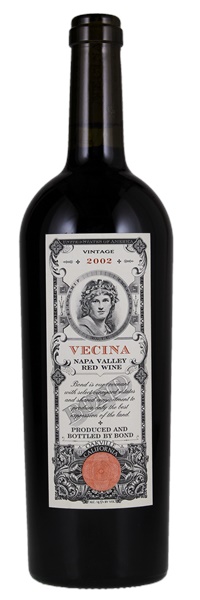Estimate

A smooth, round-textured wine that serves up multiple layers of complexity and flavor. Black cherry, blackberry and olive notes are at the fore. Spice, cedar, raspberry, toast and vanilla flavors are also firmly in evidence...
Wonderful complexity, richness and purity of flavor, with layers of herb, currant, earth and juicy wild berry, turning to a touch of balsamic. Loads of flavor and a long, intricate aftertaste...
...Explosive, wild nose combines roasted red berries, grilled meat, tar, brown sugar, mocha and truffle. Dense but juicy...Intriguing notes of smoke, herbs and truffle. Finishes with very smooth, fine tannins.
The 1999 Vecina, a 100% Cabernet Sauvignon offering, exhibits aromas of graphite, tar, coffee, and creme de cassis...This powerful, muscular Cabernet will be at its best between 2006-2020

A smooth, round-textured wine that serves up multiple layers of complexity and flavor. Black cherry, blackberry and olive notes are at the fore. Spice, cedar, raspberry, toast and vanilla flavors are also firmly in evidence...
Wonderful complexity, richness and purity of flavor, with layers of herb, currant, earth and juicy wild berry, turning to a touch of balsamic. Loads of flavor and a long, intricate aftertaste...
...Explosive, wild nose combines roasted red berries, grilled meat, tar, brown sugar, mocha and truffle. Dense but juicy...Intriguing notes of smoke, herbs and truffle. Finishes with very smooth, fine tannins.
The 1999 Vecina, a 100% Cabernet Sauvignon offering, exhibits aromas of graphite, tar, coffee, and creme de cassis...This powerful, muscular Cabernet will be at its best between 2006-2020

A smooth, round-textured wine that serves up multiple layers of complexity and flavor. Black cherry, blackberry and olive notes are at the fore. Spice, cedar, raspberry, toast and vanilla flavors are also firmly in evidence...
Wonderful complexity, richness and purity of flavor, with layers of herb, currant, earth and juicy wild berry, turning to a touch of balsamic. Loads of flavor and a long, intricate aftertaste...
...Explosive, wild nose combines roasted red berries, grilled meat, tar, brown sugar, mocha and truffle. Dense but juicy...Intriguing notes of smoke, herbs and truffle. Finishes with very smooth, fine tannins.
The 1999 Vecina, a 100% Cabernet Sauvignon offering, exhibits aromas of graphite, tar, coffee, and creme de cassis...This powerful, muscular Cabernet will be at its best between 2006-2020

A smooth, round-textured wine that serves up multiple layers of complexity and flavor. Black cherry, blackberry and olive notes are at the fore. Spice, cedar, raspberry, toast and vanilla flavors are also firmly in evidence...
Wonderful complexity, richness and purity of flavor, with layers of herb, currant, earth and juicy wild berry, turning to a touch of balsamic. Loads of flavor and a long, intricate aftertaste...
...Explosive, wild nose combines roasted red berries, grilled meat, tar, brown sugar, mocha and truffle. Dense but juicy...Intriguing notes of smoke, herbs and truffle. Finishes with very smooth, fine tannins.
The 1999 Vecina, a 100% Cabernet Sauvignon offering, exhibits aromas of graphite, tar, coffee, and creme de cassis...This powerful, muscular Cabernet will be at its best between 2006-2020